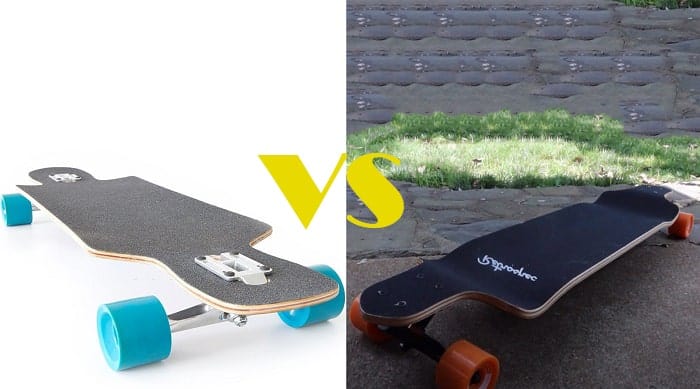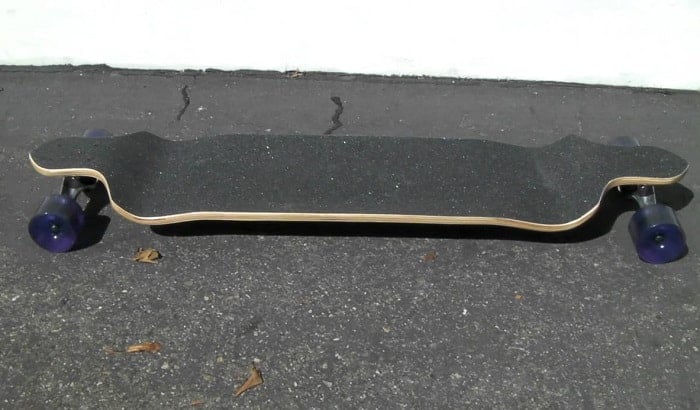The skating world is well-known for having an excessive number of products for beginner skaters to pick from. For skateboarders who want a longboard, the problem is finding one that suits their specific needs.
The two longboards that start the arguments are drop through vs drop down decks, and this article focuses on them. Because the two longboards appear the same, it makes it hard to pick between them.
Once you grasp the core difference between drop down drop through longboard styles and purposes, your search for a board may be narrowed down. I will make sure that by the end of your reading, you will be a lot more knowledgeable to make your decision.
In general, if you are more interested in traveling and commuting, the drop-down deck is perfect for you. Meanwhile, the drop-through model gives you the combination of speed and mobility. Keep reading for more details.
Table of Contents
Drop Through vs. Drop Down Comparison
Drop Through Longboards
Drop through decks are more suited to cruiser style riding due to their construction being more flexible than drop down decks. Additionally, they are quite easy to handle and maneuver.
They feature a minimal center of mass, making them suitable for inexperienced riders. The reduced center of gravity contributes to their endurance at full speed, albeit not as much as the drop down longboard.
Due to the fact that drop through boards are usually flexier than top mounted or drop down deck boards, taking them to greater speeds is possible but not recommended.
Additionally, the lower deck of drop through boards facilitates easy pushing and foot braking while freeriding. The drop through’s lower center of gravity also facilitates sliding.
Drop throughs are considerably more forgiving of errors than the dropdown form. Beginners frequently carry too much speed into bends, particularly when starting to go downhill. They also kick off excessively hard on slides.
Drop throughs are the safer choice for beginner longboard users as they learn to moderate their effort and monitor their speed before turns. This is possible due to the drop through’s greater carving abilities and naturally superior traction.
The drop deck longboard has some drawbacks, one of which is its poorer grip while turning, specifically at high speeds. The pressure concentration on the bolts and nuts decreases the deck’s architectural strength, but the flex compensates for this.
- Great for a cruiser riding style
- Easy to control and maneuver due to flexible construction
- Reduced center of gravity allows higher endurance at high speeds
- Easier pushing and foot braking while freeriding
- Made for sliding
- Best for carving and superior traction; better for beginners than drop downs
- Not as good with high speeds as the drop down longboard
- Less grip compared to other design options
Drop Down Longboards
A drop down longboard deck is simply a top mount with a concave that lowers you to a level below your trucks. These boards are excellent for all sorts of riding, but my particular favorite is to just ride around the local neighborhood.
They provide more traction than a drop through, which allows for easier sliding. When it comes to sturdiness, these decks are the drop platform longboards to choose from.
The drop down is designed for technical riders and is intended for more technical skating. It is designed with a curvy platform that’s at the back of the truck, creating an incredibly rigid deck.
The trucks are mounted in the traditional manner, with the platform resting on the base plates. This arrangement equally distributes the rider’s weight over the trucks, resulting in a highly stable ride.
The lower center of gravity (lower than a drop-through) allows you to have a greater degree of gripping. When you slide it, you have a better grip on it.
Having a drop down is wonderful when it comes to pushing and commuting, because you don’t have to exert yourself much in order to get to the proper control you need. When you’re pushing on the drop down, you won’t feel exhausted because you aren’t riding at full force.
Curving the board downward aligns the feet with the truck’s axis. There is less pressure exerted on the vehicles’ trucks. As a result, the drop down configuration is far easier to kick sideways into a slide than most other forms.
Additionally, it requires less work to re-establish a straight line. Once the wheels are aligned with the direction of travel, the ride rapidly returns to its naturally stable state.
This is entirely attributable to the fact that the center of gravity is lower. I’d suggest the drop down for all sorts of riding, including long distance pushing, pumping, and freeriding.
While a lower standing platform provides significantly more steadiness and ease of sliding, it is not desirable for some things. If you like downhill riding and taking sharp lines, a drop down is not the greatest option.
If you enter a corner at high speeds, you may not be able to control the board optimally. When kicking into a slide using a dropdown, you will go considerably further than desired and will be unable to spin your board as sharply as you want.
- More traction and durability than a dropthrough
- Designed for technical riding with its rigid deck
- Sturdy travels due to its weight distribution
- Amazing level of grip due to its low center of gravity
- For pushing, commuting, pumping, and freeriding
- Not for downhill riding and taking sharp turns at high speeds
Conclusion
Both drop through and drop down longboard platforms result in noticeable differences in the overall riding qualities. Riders who are beginning may notice little differences between drop through vs drop down initially. However, when they focus on a particular discipline, most often they choose one type of product over the other.
For different types of boarders, different longboards make all the difference; therefore, it’s essential to select correctly. It is, however, a matter of personal taste how your board is attached. Whether it is a drop down vs drop through, go ahead. My advice is to start with what works best for your style and then proceed to explore with your second board.






